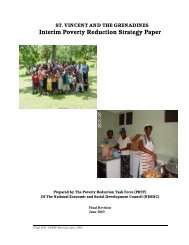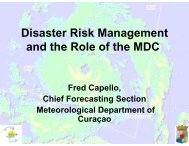The Anatomy of A Silent Crisis The Anatomy of A Silent Crisis
The Anatomy of A Silent Crisis The Anatomy of A Silent Crisis
The Anatomy of A Silent Crisis The Anatomy of A Silent Crisis
- TAGS
- anatomy
- www.bb.undp.org
Create successful ePaper yourself
Turn your PDF publications into a flip-book with our unique Google optimized e-Paper software.
46 Forum 2009: Climate Change – <strong>The</strong> <strong>Anatomy</strong> <strong>of</strong> a <strong>Silent</strong> <strong>Crisis</strong><br />
Displacement<br />
Climate change displaces people<br />
Climate change causes displacement <strong>of</strong> people in several ways, the most obvious—and<br />
dramatic—being through the increased number and severity <strong>of</strong> weather-related disasters which<br />
destroy homes and habitats forcing people to seek shelter or livelihoods elsewhere. In the long<br />
term, such environmental effects <strong>of</strong> climate change as desertification and rising sea levels gradually<br />
doom livelihoods and force communities to abandon traditional homelands for more accommodating<br />
environments. This is currently happening in areas <strong>of</strong> Africa’s Sahel, the semi-arid belt that spans the<br />
continent just below its northern deserts. Deteriorating environments triggered by climate change can<br />
also lead to increased conflict over resources which in turn can displace people. 143,144<br />
However, the links between the gradual environmental degradation <strong>of</strong> climate change and<br />
displacement are complex: When individuals decide over time to leave, it is impossible to single out<br />
the influence <strong>of</strong> climate change in these decisions from other factors, such as poverty, population<br />
growth or employment options. According to the UN High Commissioner for Refugees, it will become<br />
increasingly difficult to categorize any displaced people by separate causes, which may include<br />
any combination <strong>of</strong> conflict, economic, environmental, climate or other factors. Neither the UN<br />
Framework Convention on Climate Change nor its Kyoto Protocol, an international agreement on<br />
climate change, includes any provisions concerning specific assistance or protection for those who<br />
will be directly affected by climate change. <strong>The</strong> current terminology is the following:<br />
• Refugee: Under the 1951 United Nations Convention Relating to the Status <strong>of</strong> Refugees and later<br />
expanded through a 1967 Protocol relating to the Status <strong>of</strong> Refugees, a refugee is a person who<br />
“owing to well-founded fear <strong>of</strong> persecution for reasons <strong>of</strong> race, religion, nationality, membership <strong>of</strong><br />
a particular social group or political opinions, is outside the country <strong>of</strong> his nationality and is unable<br />
or, owing to such fear, is unwilling to avail himself <strong>of</strong> the protection <strong>of</strong> that country, or who, not<br />
having a nationality and being outside <strong>of</strong> the country <strong>of</strong> his former habitual residence as a result <strong>of</strong><br />
such events, is unable or, owing to such fear, is unwilling to return to it”. 145<br />
• Internally Displaced People: While there is no legal definition a widely recognized United Nations<br />
report, “Guiding Principles on Internal Displacement”, uses the following definition: Persons or<br />
groups <strong>of</strong> persons who have been forced or obliged to flee or to leave their homes or places<br />
<strong>of</strong> habitual residence, in particular as a result <strong>of</strong> or in order to avoid the effects <strong>of</strong> armed<br />
conflict, situations <strong>of</strong> generalized violence, violations <strong>of</strong> human rights or natural or human-made<br />
disasters, and who have not crossed an internationally recognized State border. 146<br />
• Migrant: International migrants are those who leave their country to settle in another country,<br />
voluntary or involuntary and temporarily or permanently. Voluntary migrants normally leave their<br />
country in search <strong>of</strong> a higher standard <strong>of</strong> living and quality <strong>of</strong> life elsewhere, typically referred to<br />
as economic migration. Involuntary migrants include victims <strong>of</strong> human trafficking, whose special<br />
situation is addressed by a number <strong>of</strong> international legal instruments. 147







